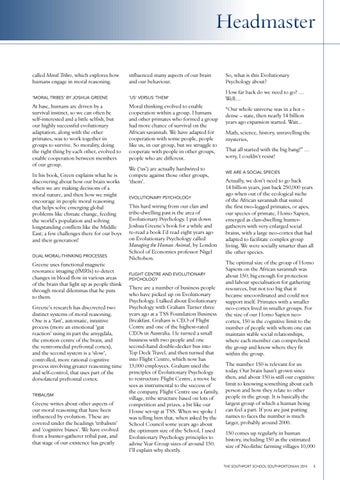Headmaster called Moral Tribes, which explores how humans engage in moral reasoning.
influenced many aspects of our brain and our behaviour.
So, what is this Evolutionary Psychology about?
’MORAL TRIBES’ BY JOSHUA GREENE
’US’ VERSUS ’THEM’
How far back do we need to go? … Well…
At base, humans are driven by a survival instinct, so we can often be self-interested and a little selfish, but our highly successful evolutionary adaptation, along with the other primates, was to work together in groups to survive. So morality, doing the right thing by each other, evolved to enable cooperation between members of our group.
Moral thinking evolved to enable cooperation within a group. Humans and other primates who formed a group had more chance of survival on the African savannah. We have adapted for cooperation with some people, people like us, in our group, but we struggle to cooperate with people in other groups, people who are different.
In his book, Green explains what he is discovering about how our brain works when we are making decisions of a moral nature, and then how we might encourage in people moral reasoning that helps solve emerging global problems like climate change, feeding the world’s population and solving longstanding conflicts like the Middle East; a few challenges there for our boys and their generation! DUAL MORAL-THINKING PROCESSES
Greene uses functional magnetic resonance imaging (fMRIs) to detect changes in blood flow in various areas of the brain that light up as people think through moral dilemmas that he puts to them. Greene’s research has discovered two distinct systems of moral reasoning. One is a ‘fast’, automatic, intuitive process (more an emotional ‘gut reaction’ using in part the amygdala, the emotion centre of the brain, and the ventromedial prefrontal cortex), and the second system is a ‘slow’, controlled, more rational cognitive process involving greater reasoning time and self-control, that uses part of the dorsolateral prefrontal cortex. TRIBALISM
Greene writes about other aspects of our moral reasoning that have been influenced by evolution. These are covered under the headings ‘tribalism’ and ‘cognitive biases’. We have evolved from a hunter-gatherer tribal past, and that stage of our existence has greatly
We (‘us’) are actually hardwired to compete against those other groups, ‘them’. EVOLUTIONARY PSYCHOLOGY
This hard wiring from our clan and tribe-dwelling past is the area of Evolutionary Psychology. I put down Joshua Greene’s book for a while and re-read a book I’d read eight years ago on Evolutionary Psychology called Managing the Human Animal, by London School of Economics professor Nigel Nicholson. FLIGHT CENTRE AND EVOLUTIONARY PSYCHOLOGY
There are a number of business people who have picked up on Evolutionary Psychology. I talked about Evolutionary Psychology with Graham Turner three years ago at a TSS Foundation Business Breakfast. Graham is CEO of Flight Centre and one of the highest-rated CEOs in Australia. He turned a small business with two people and one second-hand double-decker bus into Top Deck Travel, and then turned that into Flight Centre, which now has 13,000 employees. Graham used the principles of Evolutionary Psychology to restructure Flight Centre, a move he sees as instrumental to the success of the company. Flight Centre use a family, village, tribe structure based on lots of competition and prizes, a bit like our House set-up at TSS. When we spoke I was telling him that, when asked by the School Council some years ago about the optimum size of the School, I used Evolutionary Psychology principles to advise Year Group sizes of around 150. I’ll explain why shortly.
“Our whole universe was in a hot – dense – state, then nearly 14 billion years ago expansion started. Wait... Math, science, history, unravelling the mysteries, That all started with the big bang!” … sorry, I couldn’t resist! WE ARE A SOCIAL SPECIES
Actually, we don’t need to go back 14 billion years, just back 250,000 years ago when out of the ecological niche of the African savannah that suited the first two-legged primates, or apes, our species of primate, Homo Sapien, emerged as clan-dwelling huntergatherers with very enlarged social brains, with a large neo-cortex that had adapted to facilitate complex group living. We were socially smarter than all the other species. The optimal size of the group of Homo Sapiens on the African savannah was about 150; big enough for protection and labour specialisation for gathering resources, but not too big that it became uncoordinated and could not support itself. Primates with a smaller neo-cortex lived in smaller groups. For the size of our Homo Sapien neocortex, 150 is the cognitive limit to the number of people with whom one can maintain stable social relationships, where each member can comprehend the group and know where they fit within the group. The number 150 is relevant for us today. Our brain hasn’t grown since then, and about 150 is still our cognitive limit to knowing something about each person and how they relate to other people in the group. It is basically the largest group of which a human being can feel a part. If you are just putting names to faces the number is much larger, probably around 2000. 150 comes up regularly in human history, including 150 as the estimated size of Neolithic farming villages 10,000
THE SOUTHPORT SCHOOL SOUTHPORTONIAN 2014
5






















































